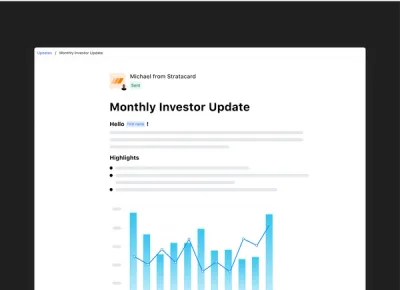Blog
Visible Blog
Resources to support ambitious founders and the investors who back them.
All
Fundraising Metrics and data Product Updates Operations Hiring & Talent Reporting Customer Stories

founders
Fundraising
An Investor is Ready to Fund Your Company. Now What?
When an investor tells you they’d like to fund your company, it may feel like you’ve reached the finish line. The hard work and time you’ve put in to fundraising is finally paying off, and soon enough you’ll have the resources you need to grow your business.
Not so fast. As any good salesperson will tell you, there’s a big difference between “I’d like to close” and actually closing. From getting partner buy-in to completing due diligence, there’s a lot to think about when closing a new investor. If you know this, and are properly prepared, you can reduce the time it takes to get your check, plus save yourself a lot of headache. Here are a few things you can do to make the process smooth.
Be prepared
OK, so this is cheating a bit. This part actually happens before an investor tells you they want to fund your company. This is the prep work you do before going in to formal pitch meetings to make sure you can respond quickly when a potential investor wants more information.
Christoph Janz provides a great overview of how to do this kind of preparation in “6 things to pre-empt 90% of due diligence.” Most of the guidance here is around preparing the metrics that investors will want to see. Having all of this data at the ready can speed up the closing process dramatically.
Janz encourages startup leaders to create a dashboard for investors that is clean, comprehensible, and uses the right terms. If you need assistance with that, I happen to know of a product that can help.
Understand the process
With preparation out of the way, we come back to the moment of investor interest. Once the investor says they want to fund you, it’s time to ask some questions. If you’ve done sales in the past, you should know what this looks like, because the questions are very similar to those you’d ask at the end of a good sales call:
“Who else needs to be involved?” – As David Teten points out, you may only meet with one partner at a fund, but that doesn’t mean they’re the only one you have to persuade. Understanding the internal approval process will help you set your own expectations, and help you XXX
“What will you need from me?” – This is where your preparation comes in handy. If you’ve done it correctly, you’ll have most of what the investor asks for ready to go. You can even send an FAQ doc and metrics dashboard right after the meeting, which will demonstrate your transparency and preparedness. Then you can gather any additional data while the investor has some internal conversations.
“What’s the timeline?” – Again, you’re establishing expectations here. Not only does asking for a timeline allow you to plan accordingly, but it also injects a little accountability on the investor’s part. If they give you a time frame to complete the process, you can (politely) hold them to it.
“What could go wrong?” – It’s a scary question, but it’s one you should ask. If you know what could stand in the way of securing funding, you’ll be able to work to prevent it.
Do your part
If you’ve done your prep work and asked the right questions, the closing process should be relatively straightforward. Bumps in the road do happen, though, and you should be ready to adjust accordingly.
The key is good communication. That means responding quickly to new questions that come up, being as transparent as you can reasonably be, and being professionally persistent with follow-up. Establishing a timeline early in the process gives you something to reference back to later. Any updates or changes on your side should be communicated proactively as well.
Above all, remember that this closing process is the beginning of a relationship—a relationship that is very important to the future of your business. By starting the relationship off with good communication and the right expectations, not only will you shorten the time it takes to get your funding, but you’ll also be setting yourself up for a successful and productive future with you new investor.

founders
Fundraising
Reporting
A Guide to How Venture Capital Works for Startups and New Investors
What is Venture Capital?
Venture capital is oftentimes a glorified funding option in Silicon Valley and the startup world. In short, it is a funding option that allows VC funds to buy equity in a startup. In turn, a startup is giving up a percentage of its ownership with the hopes of growing its valuation and creating a successful exit for everyone on the cap table.
As put by the team at Investopedia, “Venture capital (VC) is a form of private equity and a type of financing that investors provide to startup companies and small businesses that are believed to have long-term growth potential. Venture capital generally comes from well-off investors, investment banks, and any other financial institutions.”
To better understand the topic, find out more about the types of venture capital funding, when it’s used, potential benefits and pitfalls, the origins, and what it’s like to work for a venture-backed business.
Related resource: How to Get Into Venture Capital: A Beginner’s Guide
Who is Involved in Venture Capital?
To better understand venture capital, you need to understand the people and players involved. For a quick rundown check out the definitions below:
VC Fund — As put by the team at Investopedia, “Venture capital (VC) is a form of private equity and a type of financing that investors provide to startup companies and small businesses that are believed to have long-term growth potential. Venture capital generally comes from well-off investors, investment banks, and any other financial institutions.”
General Partner — As put by the team at AngelList, “The general partner of a venture fund raises and allocates investor capital and supports the founders of the companies they invest in.”
Limited Partners — As put by the team at VC Lab, “Limited Partners (LPs) are investors in your fund that provide capital. The most common types of LPs are high net worth individuals, pension funds, family offices, sovereign funds and insurance companies – just to name a few.”
Let’s start with the entrepreneur or startup founder. If a founder is looking for capital for their business they might look to venture capital. As we mentioned above, venture capital is an equity funding option for startups.
VC firms and funds invest in many companies (and the best ones are able to raise multiple funds). At the end of the day they are looking to create outsized returns for their investors. So who are their investors? Limited partners. LPs have limited control over the management of the VC fund. However, it is important to understand the LP <> GP/VC fund relationship to understand a VC fund’s motives.
Limited partners are generally large investment firms that are investing across many asset groups — many of them public markets. As investing in VC funds is typically a small % of their overall portfolio, it is important for VC funds to generate returns in line or greater than the public assets in their portfolio. Because of this, VC funds will turn to founders and startups with the potential to create massive returns.
Related Resource: Understanding Power Law Curves to Better Your Chances of Raising Venture Capital
How Venture Capital Firms Work
To best understand how a VC fund works you need to understand where they get their capital from and how they make money themselves. As we wrote in our Ultimate Guide to Fundraising, “In simplest terms, VCs go through a consistent life cycle that goes something like this: raise capital from LPs, generate returns through risky venture investments, generate returns in 10-12 years, and do it again.”
At the start of a VCs lifecycle, they raise capital from limited partners (LPs). LPs are generally institutional investors (pension funds, endowment funds, family offices, etc.) that use venture capital funds to diversify their investments. From here, a VC deploys the capital they’ve raised from LPs into startups and other investments with the goal of generating returns for their LPs.
Venture capital funds have traditionally been a very risky investment (with a huge upside) so LPs will generally only put a small percentage of their capital into venture funds. As Scott Kupor, Managing Partner at Andreessen Horowitz, mentioned in his book, Secrets of Sand Hill Road, “If you invested in the median returning VC firm, you would have tied up your money for a long time and have generated worse results than the same investment in Nasdaq or S&P 500.”
10-12 years after raising a fund, VCs are expected to generate returns for their LPs. If a fund manages to generate meaningful returns for their LPs they will raise another round and repeat the cycle.
In fact, VC funds follow a power law curve — a small % of funds, generate a large % of returns. Internally, VC funds also follow a power-law curve — meaning a small % of their startup investments create a large % of their returns for LPs. This means that VC funds are in search of startups that have the opportunity to generate massive returns and “return the fund” to their LPs. As we wrote in our post on power-law curves,
“This means that a small % of VC funds take home a large % of venture returns. VCs are constantly working to make their way into the “winning” part of the curve so they can continue to attract capital from limited partners.
How does a VC fund become a “winner?” The best VC funds portfolio returns also follow a power-law curve. A small % of a VC fund’s investments will yield the majority of its returns. What does all of this mean for a founder?”
Only a small percentage of funds create large returns, which means a majority fail. If a VC fund fails it means that its investments are also failing — or failing to generate the huge returns they need.
Related resource: Understanding the Advantages and Disadvantages of Venture Capital for Startups
Private Equity vs. Venture Capital
Venture capital is technically a form of private equity. However, venture capital focuses on all equity and smaller investments that reward high-risk, high-reward scenarios. On the flip side, private equity firms are generally geared towards later stage companies that have a proven track record.
Related Resource: Private Equity vs Venture Capital: Critical Differences
Angel Investors vs. Venture Capitalists
An angel investor is generally a wealthy individual who is looking to invest spare cash in an alternative investment. Unlike a VC, angel investors are not professionals nor do they have limited partners investing in them. Angel investors are typically more hands-off and can be a great source for introductions to other investors, customers, and others.
Related Resource: How to Find Investors
Types of Venture Capital
Typical explanations of the types of venture capital divide it into three main groups, based on the business stage that needs funding. This list provides a brief explanation of these venture capital types and the various business stages that they may apply to:
Related Reading: A Quick Overview on VC Fund Structure
Early-stage
This might include seed financing, Series A funding, etc. which is usually just a small amount of capital that will help the founders qualify for other loans. True startup financing provides enough capital to finish a service’s or product’s development. In contrast, startups might also get first-stage financing after they have finished development and need more funds to begin operating as full-scale business.
For example, Crunchbase and newsletters are full of new VC deals being completed every day. You can check out Uber’s timeline of early-stage funding rounds here.
Expansion
This kind of venture capital helps smaller companies expand significantly. For instance, a thriving restaurant may decide it’s time to open more locations in nearby communities. Sometimes, it also comes in the form of a bridge loan for businesses that want to offer an IPO.
For example, if you take a look at Uber’s timeline of investments you’ll notice they start raising massive rounds via private equity around 2015 as they gear up for an IPO.
Acquisition
Sometimes called buyout financing, this type of funding may help acquire other businesses or sometimes, just parts of them. For instance, some groups may use acquisition financing to buy into a particular product or concept, rather than using it for buying the entire company.
Pros and Cons of Venture Funding for Startups and Small Businesses
Pros of Venture Funding
Venture funding comes with a number of advantages. One of the beauties of venture capital is the fact that a founder has to invest no capital of their own so they can grow at a rapid rate.
No Personal Capital
One of the biggest advantages of raising venture capital is that you do not have to use any of your personal capital. You can grow your company and valuation while deploying others’ capital. However, this does come with high expectations and responsibility.
Investor Support
As VC funds continue to innovate, the support they provide startups has continued to evolve. VC funds will help founders with anything from determining go-to-market motions to mental health to hiring & fundraising.
Extensive Network
The startup & VC world is a tightknit community. Many VC funds and their partners have extensive networks of other funds, founders, potential hires, and customers.
Enhanced Growth
VC funds allow companies to deploy millions of dollars in capital and grow at a quicker rate than they would with alternative venture funding options.
Cons of Venture Funding
Of course, on the flip side there are some disadvantages. While venture capital offers the opportunity to grow rapidly, it also has some downsides when it comes to ownership.
Increased Dilution
Raising venture capital means you are selling equity in your company. Because of this, founders will own a smaller percentage of their company.
Convoluted Decision-Making
Because of their diminished ownership, founders can potentially lose their ability to make decisions solely based on their needs and have to take into consideration the needs of their investors and partners.
Long-Winded Time Commitment
Fundraising can be an incredibly time-consuming and difficult process for many startup founders. It can take away a founder’s time from focusing on building or selling a product.
If you’ve determined that venture capital may not be the best option for you there are always alternatives. Over the last few years, there has been an explosion of funding options that are founder-friendly. Check out some population options here.
The Process of Getting Funded by a Venture Capital Firm
At Visible we like to compare a venture capital fundraise to a B2B sales funnel. You are adding potential investors to the top of your funnel, taking meetings and nurturing them in the middle, and closing them, and onboarding them to your cap table at the bottom. Below are 6 high-level steps. If you’re interested in a more in-depth look check out our Ultimate Guide to Fundraising.
Step 1: Determine if VC is Right for Your Business
The first step to getting funded by a venture capital firm is to understand if venture capital is right for your business. This means that you believe you can grow at a rapid clip and generate massive returns for a VC fund to return to their LPs. Before setting out to build a list of investors, we suggest picturing what your ideal investor looks like and building out a list from there.
Over the course of a fundraise, we recommend building a list of 50+ investors. It is important to keep this in mind when building a list and founding routes for introductions. Learn more about why 50-100 investors in our post here.
Step 2: Prepare Your Deck, Docs, and Metrics
If you believe you have what it takes to raise venture capital you need to start putting the pieces in place to get started. Going into a fundraise, you should have docs (pitch deck, financials, cap table, etc.) and your core metrics ready to go. Learn more about preparing your pitch deck and other documents here.
Step 3: Find Investors
Once you have your documents in place it is time to start finding investors for your business. It is important to make sure that you find investors that are right for your business. The average VC + founder relationship is 8-10 years so it is important to make sure you are starting a relationship with the right funds and person.
Learn more about the ideal investor persona here.
Step 4: Pitch Investors and Take Meetings
Once you start reaching out to investors (cold outreach or warm introductions) you’ll start sitting meetings and have the opportunities to pitch investors.
Check out our guide for meeting with and pitching investors here.
If you find an investor who is ready to fund your business, awesome! You’ll move on to the following steps. For a more in-depth look at the next steps, check out our blog post here.
Step 5: Due Diligence
After a pitch, if an investor decides they want to move forward with an investment they will begin due diligence. You can expect an investor to audit your financials, survey your employees and customers, and deeper study the market. Great VCs will offer a checklist to help set expectations during the due diligence process. Over the course of due diligence, you will likely need to share a data room. Learn more about how you can build a data room with Visible below:
Related Resource: What Should be in a Startup’s Data Room?
Step 6: The Term Sheet
If you make it past due diligence, you will be presented with a term sheet. If the terms look good, you are set! Learn more about navigating your term sheet here.
Origins of Venture Capital
In one way or another, forms of venture capital have probably financed innovations since people latched onto the idea of bartering. For instance, a plucky inventor may have come up with a better idea for a grindstone but lacked the resources to create it on his own. Another villager may have liked the idea, so he exchanged stone and labor for part ownership in the new and better-milled grain producer.
Still, for much of the history of venture capital, investors favored loans over equity. In the past, investors lacked ways to gain good information about all the details of a business. Also, until fairly recently, the concept of limited liability did not exist as it does now. Investors feared that they may offer money to a company in exchange for part ownership. In exchange, they might get unpleasantly surprised by massive debts that the original founders had already piled up. As part-owners, they would also face partial responsibility for these loans. The concept of limited liability helped relieve some of these concerns and encourage more equity funding.
It took until after WWII for the United States to develop a true private equity system. An investment of $70,000 in DEC in 1957 gained credit as one of the early success stories after that initial funding grew to $35 million by the IPO in 1968. The Great Recession changed the nature of venture capitalists to some degree. Most lately, venture capital groups have focused more upon offering other value, besides just funding, to the small businesses or startups they want to help fund.
As mentioned above, part of the deal may include business expertise, facilities, and other helpful assets beyond money. Thus, many venture capitalists look for startups or small businesses that they understand how to fix or help, beyond those that just need investments.
Working for a Venture-Backed Company
How is working for a venture-backed company different from working within an established corporation? As we noted in our guide to Startup Culture, working for a startup can offer employees many of the same benefits that investing in one provides venture capital providers. Of course, employees may not initially enjoy the large salaries and perks that a large and established corporation can provide. A few perks of working at a venture-backed company over a large corporation:
Ownership — the ability to own projects and individual metrics that move the company forward.
Collaboration — have the opportunity to work cross-functionally with other teams and individuals
Growth — quickly advance and grow your skills as the company grows.
Because the company is small, employees may need to wear multiple hats, and some employees enjoy the challenge and chance to explore various facets of their company. In lieu of the highest salaries or best retirement plan, some startups also offer flexible schedules and other soft benefits that might also appeal to some very good employees. Working for a venture-backed company offers some challenges over taking a job with an established firm; however, the right startup or small business can also promise great rewards.
Find out if VC is right for your company with Visible
Understanding how venture capital works is an important step to determining if venture capital is right for your business. If you believe venture capital is right for your business, let us help. Find investors using Visible Connect, our free investor database, to kick off your fundraise.

founders
Metrics and data
The Ultimate Customer Retention Cohort Analysis
What is a Cohort Analysis?
A cohort analysis is a study of activities for a certain segment of customers or users. In this template, we are looking at the customer cohorts for the quarter or month they were acquired, and what % of those customers were retained for subsequent quarters/months.
As summarized in Lean Analytics (via Wikipedia), “Cohort analysis is a kind of behavioral analytics that breaks the data in a data set into related groups before analysis. These groups, or cohorts, usually share common characteristics or experiences within a defined time span. Cohort analysis allows a company to “see patterns clearly across the life-cycle of a customer (or user), rather than slicing across all customers blindly without accounting for the natural cycle that a customer undergoes.”
Why Cohorts are Effective for Analyzing Data
With cohort analysis, you can start to correlate initiatives in your own business to see how they may affect the customer lifecycle. As your company scales, iterates, innovates and creates processes, you would hope to not only acquire customers at a faster pace but also retain them longer, correct? One would assume as product/market fit is found, domain experts are hired and new campaigns are launched that customer retention gets better… but how do you know?
New Product Features
In order to best understand how new product features are impacting customer retention and other metrics you will want to look at a certain cohort of customers/users. Perhaps cohort retention improved as you started to introduce features in your product to engage customers through a daily digest. By understanding how customers interacted with the new daily digest you’ll be able to use data to determine where development time and resources should be placed in the future.
New Marketing Campaigns
Startups are constantly testing new marketing channels and go-to-market efforts. Without the proper data behind a new campaign, it can be difficult to determine what cohorts and campaigns are performing best. For example, maybe you introduce paid search as a marketing strategy, then realize retention drops because customers acquired through paid were not the ideal customer type. This should be a clear indicator that you either need to (1) improve different aspects of your paid funnel or (2) focus the time and energy on paid channels on different channels.
New Customer Onboarding
For SaaS companies and service providers, onboarding new customers is vital to their retention and growth with the product and your organization. Onboarding flows are constantly being tested and tweaked to convert your customers as best as possible. For example, let’s say you add 3 questions during the signup process to better tailor a new user/customers onboarding experience and it is shown in the data that this cohort is 2x as likely to take a key action in your application, you will want to implement and improve this even further.
The 2 Types of Cohort Analysis
Cohort analysis can be a powerful tool to interpret and understand your user data. While you can slice and dice your cohort data in a wide variety of ways, it ultimately comes down to 2 main types of cohort analysis:
Related Resource: Startup Metrics You Need to Monitor
Acquisition Cohorts
One of the main types of cohort analysis is by acquisition type. As we mentioned in the previous section, cohorts can be valuable when analyzing marketing campaigns and efforts. By breaking down cohorts by acquisition channels, you’ll be able to better understand the specific channels that are performing best or campaigns that need to be tweaked.
Behavioral Cohorts
The other main type of cohort analysis is by behavior. This can generally be used in regard to steps taken in a product. For example, you can create a cohort of users that have taken a specific action in your product. This can be used to inform and dictate product development and strategy.
How to Build a Cohort Analysis in 4 Steps
Building a cohort analysis can be time-consuming and tricky. That is why we created a template with just a few steps to help get you started (more on using our template later). At the end of the day, if you are creating a cohort analysis from scratch or plan on using our template there are a few steps you’ll need to take before you can get started
1) Start with a Goal and Questions
When building a cohort analysis you first need to figure out what the goal of the analysis is. At the end of the day the goal of a cohort analysis is to better inform your team to make decisions around product, marketing, customer experience, etc. If you’re not setting expectations and questions you want to answer, you can miss the point and impact of a cohort analysis.
2) Define the Metrics & Data Needed
Once you’ve determined the goal and questions you’d like to answer you need to understand what data and metrics you will need to measure and compile to execute your analysis. If you are measuring customer retention, you will want to start with clean data around your customer base. For example, you will want to have a grasp on contract size, sign up dates, churn dates, etc.
Depending on what you are tracking, it may require a deeper layer of data. For example, if you are looking at a specific marketing channel, you will likely want to include this data as well. Having cleaning and correct data is essential to making sure your analysis is effective as possible.
3) Perform the Analysis
There are countless tools and resources available to help performt the actual analysis. For example, Google Analytics has a builtin tool to perform cohort analysis but that requires your Google Analytics data to be 100% clean. To help we’ve created a tool to help automatically perform the analysis in a few quick steps.
4) Study the Data
The most important part of a cohort analysis is finding actionable insights to help better inform your business and product decisions. When studying your data, it is important to keep in mind the original goal and questions you set out with. See how different cohorts can help answer these questions and make better business and product decisions in the future. Check out more about specific things you should analyze and look for in the next section:
Applications of Customer Cohort Analysis
Cohort analysis can be applied to all business models. Depending on your model, acquisition strategy, and product or service will determine how to apply a cohort analysis.
Customer Cohort Analysis in Ecommerce
In order to best understand your eCommerce efforts, you need to understand how customers are engaging with your brand, website, and product. For example, you can use a cohort analysis to see if customers from certain marketing campaigns are making repeat purchases.
Related Resource: Key Metrics to Track and Measure In the eCommerce World
Customer Cohort Analysis in Mobile App Development
In order to best develop mobile apps, you need to understand what marketing strategy and product are impacting your key usage metrics. For example, you can use a cohort analysis to see how customers going through a certain onboarding flow are engaging with your mobile app.
Customer Cohort Analysis in Digital Marketing
In order to best build a digital marketing business, you need to understand what campaigns are performing best. For example, you can use a cohort analysis to see how customers are engaging through different marketing channels and campaigns.
Customer Cohort Analysis in Online Gaming
In order to best build an online gaming business, you need to understand what strategies are getting gamers to engage with your product the most. For example, you can use a cohort analysis to see how customers who play in specific tournaments engage with your game at later dates.
Related Resource: 10 Gaming and Esports Investors You Should Know
Customer Cohort Analysis in Cybersecurity
In order to best build a cybersecurity business, you need to understand what strategies are working best to retain customers. For example, you can use a cohort analysis to see how likely it is for customers to renew and expand their contracts that come from certain campaigns.
Related Resource: 10 Cybersecurity VCs You Should Know About
How to Build a Cohort Analysis for Customer Success
As we mentioned above a cohort analysis can be extremely useful for making better business and product decisions. One of the key aspects of this is how it can impact customer success and your retention efforts. Our template has a deep focus on customer retention and allows you to look back at different cohorts to see how you can improve retention efforts.
Revenue Retention
In our SaaS Metrics Guide we discuss the importance of retention. As we put it, “Poor customer retention isn’t just bad for finances; it’s an indicator that there could be a core issue with the solution itself. Customer retention rates are always a major feature of revenue development.”
At its core, a cohort analysis is best for measuring customer and revenue retention. While it could be an array of factors, understanding what cohorts are most likely to stay customers and have the highest lifetime value is essential. This may start with a top of funnel problem or may it is a product problem.
By taking aim at improving your net and gross revenue retention, a cohort analysis can be a valuable tool.
Customer Lifetime Value
As defined in our Customer Acquisition Costs Guide, “Customer lifetime value quantifies the value of what the customer acquisition actually brought into the business. Without customer lifetime value, you know how much every customer cost to bring in, but you don’t know how much those customers were worth.”
This idea goes hand-in-hand with gross and net revenue retention. If a cohort of customers has a higher customer lifetime value, why is that? Was there a particular onboarding process or channel that was prevalent that led to a higher LTV? If a cohort of customers has a lower lifetime value, why is that? Was a certain channel performing poorly? Did you remove a step from onboarding that may have reduced activation and in turn forced customers to churn sooner?
Measuring customer lifetime value is an incredibly valuable aspect of a cohort analysis. By finding the customers that are more likely to stick around, you can focus on what is working and apply it across your customer base and product moving forward.
Onboarding and Engagement
When analyzing different cohorts of customers you can look at things like onboarding and engagement campaigns during their lifecycle. Whether a software company or service provider, customer onboarding is constantly always changing. It could be a new questionnaire during onboarding or more touch points from a customer success representative. Oftentimes onboarding can be an integral part of how quickly a customer finds value and sets the tone moving forward. If there is a radical change to onboarding and customer engagement, it has the opportunity to impact their lifetime value and likelihood of churn.
New Products and Services
Startups are constantly testing different product and service offerings. Use a customer cohort analysis to determine how they impacted your revenue retention months later. If customers that activated a new feature or product are more likely to stay onboard, see how you can fit this into your customer success messaging and onboarding.
Discounts and Promotions
What good is offering a discount if you cannot see how it ultimately affects your revenue. If you offer customers a discount at the end of a quarter or month, see how likely they are to stay onboard once the promotion or discount expires. If you find customers that activated a promotion or discount ultimately churn sooner, it may be worth putting that time and energy into cohorts of customers who you know have a higher lifetime value.
What are the Benefits of Customer Cohort Analysis?
As we’ve alluded to throughout this post, there are countless benefits to building and analyzing different customer cohorts. Learn more about a few key benefits below:
Inform Product Development
Cohort analysis can be used to break down segments of customers based on their product usage. Because of this, you can understand what product features lead to your best customers. This can be used to inform product development and strategy down the road.
Related Resource: How SaaS Companies Can Best Leverage a Product-led Growth Strategy
Focus on Acquisition Channels
Another major benefit of analyzing different customer cohorts is by breaking down different acquisition channels and strategies. By evaluating cohorts based on their source channel, you’ll be able to better understand what strategies and channels you should be investing in further.
Improve Customer Success & Onboarding
Looking at the bottom of your funnel, you can analyze your customers by the customer success and onboarding strategies used. For example, if you are testing a dedicated customer success representative for a certain set of customers you’ll be able to determine if it is worth rolling out this strategy across all of your customers.
Our Customer Retention Cohort Analysis Google Sheet Template
Building a customer retention cohort analysis can be a time suck which is why we are open sourcing our template with you today. Our template provides entry of customer data in two different ways, in addition to supporting tracking over quarters and months.
Everything you need can be found in the instructions tab of the template. This template will allow you to get data from the previous eight quarters and is completely automated. A quick explainer:
Decide if you want to enter row level data of your customers, simply head to the “Customer Data” tab, remove all of the fake data we’ve entered, and enter in your own data. This will automatically fuel the other tabs and be the start of your cohort analysis.
If you’d prefer to enter simple counts of your customers at the start and end of different time periods, head to the “Customers Retained Count” tab. From here, you can enter the total customers acquired and churned during a period.
Get The Ultimate Customer Retention Cohort Analysis Template for SaaS
Use our template to correlate key business decisions to your customer acquisition and retention efforts. As your company scales, iterates, innovates and creates processes, you would hope to not only acquire customers at a faster pace, but also retain them longer, correct? One would assume as product/market fit is found, domain experts are hired and new campaigns are launched that customer retention gets better… but how do you know?
With our free template you’ll be able to:
Easily enter customer lifetime information in a pre-formatted section.
Generate a monthly and quarterly cohort analysis of your customer retention efforts.
Compare your cohort analysis against company milestones to understand what is generating the highest-quality customers for your business.
Download our template below:

founders
Operations
11 VC Thought Leaders We Keep Coming Back To
For the past 3 years, we’ve been hard at work scouring the internet for content for our weekly newsletter: The Founders Forward. Over the course of building the Founders Forward, we’ve shared 1000s of articles and have gotten to know different VC thought leaders and influencers.
Below, we’ve shared 11 of the VC thought leaders we learn from again and again. Do you follow anyone that we don’t have on our list? Shoot us an email to marketing@visible.vc or send us a tweet. We’d love to build out the list even more!
Jason Lemkin
Twitter Handle: @jasonlk
Tweets About: All things SaaS with a focus on sales, investor relations, and scaling your business to $100M in Revenue.
Follow if: You are a SaaS founder or operator with an interest in learning from someone who has scaled a business to $100M in revenue.
Where to Start: 10 Great Questions to Ask a VP of Sales During an Interview, You Need to Fundraise 52 Weeks a Year. The 1-and-30 Rule.
Brad Feld
Twitter Handle: @bfeld
Tweets About: The latest tech news for founders, venture capital, and his favorite resources/books for startup leaders and operators
Follow if: If you’re interested in learning more about venture capital, learning from Brad’s portfolio companies, and lessons from his experience as the founder of Techstars and Foundry Group.
Where to Start: Capital Should Follow Talent, Disagree and Commit
Fred Wilson
Twitter Handle: @fredwilson
Tweets About: A stream of his thoughts and blog posts as the founder of Union Square Ventures with a recent focus on blockchain and crypto.
Follow if: You’re interested in learning best practices for founders from one of the most successful VCs, or want to learn more about blockchain technology.
Where to Start: The Valuation Obsession, Should Your Company be Profitable
Semil Shah
Twitter Handle: @semil
Tweets About: A stream of his thoughts on individual startups, tips and advice for founders, and what he personally looks for in an investment.
Follow if: You’re an early stage founder that has taken capital, or are getting ready to raise, and want to leverage the perspective of an early stage investor.
Where to Start: A New VC Crop of Series A Firms, Paying Attention to Inbound Deal Flow
Hunter Walk
Twitter Handle: @hunterwalk
Tweets About: Current events, his daily experiences as an investor, musings from his fund, and advice for founders.
Follow if: You have an interest in the overall venture capital market and are curious about the day-to-day decisions a VC makes.
Where to Start: What Do You Want From Me Besides Capital?, A Strong Cold Email Always Beats a Weak Warm One
Liz Cain
Twitter Handle: @elizabethjcain
Tweets About: All things hiring and developing a proficient sales team drawing on her experience launching the BDR team while at NetSuite.
Follow if: You are a startup founder or operator getting ready to build out a sales process, team, and hiring plan.
Where to Start: How to Give Effective Performance Feedback: Frameworks and Best Practices, A Product-led Approach to Sales
Christoph Janz
Twitter Handle: @chrija
Tweets About: A data-driven approach to SaaS investing across the industry, with a focus on European venture.
Follow if: You are interested in learning more about the SaaS landscape from a macro perspective, or want to know what Europe’s top firm looks for in their investments.
Where to Start: Five Ways to Build a $100M Business, Unsure How Much You Should Pay Yourself? Check out this Founder Salary Calculator
Josh Elman
Twitter Handle: @joshelman
Tweets About: Product-focused tweets focused in the consumer space.
Follow if: You are building a consumer-facing product and have questions for one of the leaders in the space—Josh is quick to respond to tweets.
Where to Start: The Only Metric that Matters, Web Scraping vs. Doing the Work
Ben Horowitz
Twitter Handle: @bhorowitz
Tweets About: His musings from being the name behind of the most successful VC funds in the world: Andressen Horowitz.
Follow if: You want to learn startup and leadership advice from the author behind The Hard Things About Hard Things. Also doesn’t hurt if you’re a fan of rap.
Where to Start: The Hard Thing About Hard Things, How to Tell the Truth
Naval Ravikant
Twitter Handle: @naval
Tweets About: Thought-provoking ideas that not only challenge you as a founder, but as an individual.
Follow if: You want to challenge your thought process, covering everything from venture capital and building a company to meditation and psychology.
Where to Start: Build a Team that Ships, Bitcoin – The Internet of Money

founders
Product Updates
Updated Navigation + Tables in Updates
If you sign into Visible today, you’ll see an updated navigation. The changes we’ve made are small, but they will accomplish a couple key items:
Make drafting, editing and sending Updates easier than ever
Set the stage for some game-changing improvements & features to be delivered later this quarter.
What, exactly, is changing?
Update drafts are now in the sidebar. Instead of a couple clicks to get into an Update, you’ll be able get there with much more ease.
We’ve fixed Settings, Metrics and Contacts to the bottom of the sidebar. We’ve also created a specific Sent Updates navigation item to quickly see the Stats of your previously sent Updates.
Our aim was to have anything you are frequently creating, viewing or editing to be prominent, near the top of of the navigation, while features that you interact with less frequently to be positioned at the bottom.
Tables—better late than never?
The same tables you use in Dashboards can now be used in Updates! What seems like a simple feature from the outside was actually a complex user experience to nail.
The team rallied and launched this feature, which many of you have requested. Thanks to Eugene (who is new on our product team) for tackling this!
Feel free to contact us with any feedback or questions you have!
Up & to the Right,
-Mike & The Visible Team

founders
Hiring & Talent
Why a Formal Interview Process is Vital to Your Startup’s Success
Hiring is hard, and hiring for a startup is even harder. Especially in the early days, every hire you make is crucial. Adding the wrong person to your team can adversely affect the entire company in a big way, slowing you down and making it that much more difficult to reach your goals. When CB Insights analyzed the main reasons startups fail, team issues ranked at #3, above big issues like competition and poor business model.
It’s little wonder that, year after year, State of Startups finds “hiring the right people” at the top of their list of concerns for startup CEOs year after year.
One of the key ways to protect against making a bad hire is to run a formal hiring process for every role you fill. Below, you’ll find out why a formal process is so important, and how you can make it work, regardless of the stage you’re at.
Why have a process?
There are plenty of reasons you might be inclined to forego a set hiring process and follow your gut. Setting up a process is a lot of work. Following a traditional interview process might feel corporate, or more appropriate for companies much larger than yours. And executing on that process with candidate after candidate takes up valuable time, and you have a company to build.
Here’s the thing—you need to be running an interview process. It drastically increases your chances of making the right hire, whether you’re adding employee number 5, 50 or 500. The time you lose running a formal process is nothing compared to the time you’ll lose if you make a bad hire.
There are plenty of resources out there about how to structure your interview process, but most aren’t written with the startup leader in mind. Here are a few steps to follow to build and run a formal interview process amidst all of your competing priorities:
Make everyone apply
When you’re starting out, your network is the best place to find quality candidates. That means you’re going to meet people you want to hire in a lot of informal ways—from star events and happy hours to LinkedIn introductions.
Here’s the thing, though: no matter how you’re introduced, eventually you need to make every candidate apply with a resume and answers to a few application or survey questions. You want everyone to begin on as even a playing field as possible. A lightweight applicant tracking system makes this easy, but you can also use a web form and a spreadsheet. Once your candidates have applied, you can use their resumes and answers to decide who you want to give more time to.
Screen liberally
With your formal applications in tow, set up a screener interview with every candidate that looks interesting. This should be a quick discussion—20 minutes at most—that gives you a sense of the person that you’re talking to. Keeping these conversations short allows you to talk with more people, and make sure that no one exceptional slips through the cracks.
Interview sparingly
This is where you can rely on your gut. If you aren’t excited about a candidate after the screener call, don’t interview them. An ideal interview takes at least an hour and typically includes more than one person at your company. That makes every interview you conduct a pretty expensive prospect, both in terms of cash and opportunity cost. Don’t interview anyone you don’t genuinely think you want to hire.
Know what you’re looking for
Before you conduct your longer interviews, you should make sure you know what you’re looking for. I generally advise making a list that includes the following items:
Must-haves
Any candidate you hire must possess these qualities, skills or experiences. You shouldn’t break these, so don’t put too many items under this category.
Important
These are qualifications or traits that are directly related to the role, but don’t disqualify someone if they don’t have them. This should be your longest list.
Bonus points
Qualifications or traits you don’t expect candidates to have, but could be a big help in the position, or to the company as a whole.
After you’ve conducted each interview, measure the candidate against this list. It’s OK to hire someone who doesn’t check every box, and it’s even OK to choose a candidate who checks fewer boxes than another candidate you interviewed, but having the list before your interviews gives you something to measure against. If you deviate from it after the fact, you’ll be making an intentional decision.
Don’t go it alone
Finally, unless you’re a company of one, you shouldn’t be conducting final interviews alone. You need at least one other person in the room to provide a different perspective on each candidate, to help you debrief after interviews and deliberate on who to hire. I’ve never been on a hiring team that had unanimous impressions of a candidate—even when they all thought the candidate should be hired. A little perspective goes a long way.
All of the above is a good outline for how a formal interview process can work at a startup. It may seem daunting at the start, but it will help you hire with confidence and increase the likelihood that you find the right candidate for each role you fill.

founders
Fundraising
Ready to Make the Jump from Seed to Series A? Think About These 3 Things.
Raising a Seed round is an incredible accomplishment. For many startups, it’s also the start of a long journey. As more companies get funded at the Seed stage, the competition for Series A capital is growing. In fact, if you are lucky enough to raise a Seed round, your chance of raising a second round is roughly 48%.
Outside of the essentials, like finding product-market fit, scaling revenue, and building a repeatable customer acquisition process, there are plenty of other important things to consider as you get ready to raise a Series A. We’ve laid out 3 of them below.
Tracking Metrics & Financial Planning
David Cummings, investor and company founder, has found that most Seed stage founders don’t track enough metrics on a weekly basis. Having a grasp of key financials and metrics will become vital when courting potential investors past the Seed stage. David suggest starting with the 9 metrics below:
Cash on hand
Weekly burn rate
Monthly recurring revenue
New customers
Lost customers
Marketing qualified leads
Sales demos
Active sales opportunities
Customer net promoter score (NPS)
To make things easier, we’ve turned those 9 metrics into a Google Sheet template you can access here.
Building the Team
Building a strong team is arguably just as important as your initial product and customer acquisition process, as it’s often a key factor investors look at when deciding to invest. As Mark Suster, Founder of Upfront Ventures, puts it, “about 70% of my investment decision of an early-stage company is the team. My rationale is simple: everything goes wrong and only great teams can respond to competitors, markets, funding environments, staff departures, PR disasters and the like.”
Having a small team that covers every major function of a business allows Seed stage companies to iterate quickly while staying capital efficient. As the team continues to grow, the fingerprints of these original team members will be all over the company culture. Not only does a strong team increase your likelihood of raising capital, the early days of hiring are a blueprint for your company culture and structure as you grow.
Engaging Outside Stakeholders
Seed stage founders are pulled in every conceivable direction. On top of building a product, building a team, and creating a repeatable sales process, founders at the Seed stage must also manage their outside stakeholders—both initial investors and the ones they hope to bring on board.
As Ari Newman, Partner at Techstars, says, “Financing is not a dot, it is a line and it is part of your job as a founder and a business leader to keep the capital coming in.”
Engaging potential investors can often draw you away from your day-to-day tasks, so it is important to have a clear process in place, just as you would with a marketing or sales lead. Courting potential investors can’t be a founder’s full time job, so adding process and structure will help protect your time.
For founders who are ready to fundraise, we built a Fundraise Tracking Tool, which helps ensure you can track your prospective investors as simply as possible. Once you have them organized, sending a quick email update every month or so will pay dividends as you get deeper in the fundraising process.
The move from Seed to Series A isn’t an easy one. It requires founders, and the teams behind them, to level up quickly. Paying attention to the above items will help ensure you and your team are set up for fundraising success.
Ready to start nurturing potential investors as you ramp up for a Series A fundraise? Start a Visible trial to send quick and beautiful investor updates here.

founders
Metrics and data
Product Updates
Salesforce Updates – Contacts & Accounts
Contact and Account Objects in Salesforce
The Visible product team just updated our Salesforce Integration. We now support the Contacts and Accounts objects in addition to the already existing Leads and Opportunities objects.
If you need a refresher on Salesforce, you can read more in our knowledge base. Contact us to send us any feedback or questions.
Up & to the right,
-Mike & The Visible Team.

founders
Operations
Themes, Not Goals – What Most Startup Leaders Get Wrong About Annual Planning
Business Planning for the New Year
It’s resolution season, which means many of us are making declarations about how many books we’ll read or how many pounds we’ll lose this year. The ball descends on December 31, and on January 1st—or maybe January 2nd, depending on our hangover level—we set out to make our resolutions a reality.
Here’s a stat that isn’t too encouraging: 80% of those resolutions will fail by February. It’s so bad that some psychologists actually suggest starting your resolutions on February 1. A major contributor to that failure rate is the lofty nature of most resolution goals. Goals are best when they’re broken down into smaller steps that are more attainable and achievable.
Instead of setting out to read 25 books this year, for instance, it’s better to aim at reading 2 books a month. Or—even better—read for 20 minutes every weekday. The end result is about the same, but the path you take to get there has incremental steps that make the goal easier to accomplish.
So what does this have to do with annual planning? Well, if you’re doing it right, you’ve already set your business goals for 2019. But, if closing out Q4 and the blur of holidays got in the way, you may be sitting down this week or next to write out your 2019 goals. And my advice is: don’t.
What I mean is, don’t try to write lofty, year-long goals. For many of the same reasons that most resolutions fail, most businesses miss the mark on their annual goals by year’s end. In fact, businesses fare even worse than resolution-writers: 90% of senior executives told The Economist they fall short of annual goals.
This is especially true in the startup world, where the rapid pace of change means the goals you have today may not even be relevant six months from now.
So instead of focusing on big annual goals, focus on themes. What themes will drive the focus of your business this year? Themes should align with your overall vision, and can be anything that is important to where you want to go. You want something that isn’t so vague that it’s meaningless, but also isn’t so specific that it’s essentially a goal with a different name.
One of the current themes here at Visible is “Time to Value.” We’re asking ourselves how we can ensure that we are having a positive impact on our customers’ businesses as soon as they start using the product.
Once you have your themes, then you can start creating monthly and quarterly goals that line up with them. Themes, then, become the lenses through which you can prioritize your efforts. If an initiative doesn’t line up with one of your themes for the year, you’ll reevaluate whether it’s really worth doing. Our “Time to Value” theme is informing everything from our product roadmap to our marketing efforts.
So, instead of setting big annual goals that you aren’t likely to reach anyway, consider choosing themes instead. If you choose them well, they’ll last a whole lot longer than your New Year’s resolutions do.
Related Resources: How to Write a Business Plan For Your Startup

founders
Fundraising
An Update Template for Kicking Off Your Fundraise
Leveraging your existing network and investors is a great way to kick off a new fundraise. Below is a quick template to share with your current investors announcing your fundraise and asking for introduction to other prospective investors.

founders
Reporting
Powderkeg Podcast: Mike Preuss and David Hall on Fundraising and Stakeholder Reporting
In the opening episode of Season 2 of the Powderkeg podcast, Mike Preuss, our CEO, and David Hall of Rise of Rest discuss fundraising between the coasts and how startups can leverage stakeholder reporting to power their business.
In this episode with David Hall and Mike Preuss, you’ll learn:
Key similarities and differences between non-coastal tech hubs (9:17).
An experienced investor’s high-level work and life advice for entrepreneurs (15:46).
The benefits that thorough stakeholder reporting can provide for every startup (22:51).
How to build a talented team and loyal customer base between the coasts (33:38).
Proven strategies for nurturing healthy founder-investor relationships(37:33).
How founders and investors should approach fundraising in non-coastal cities(49:16).
Give it a listen below or using this link. Enjoy!

founders
Fundraising
5 Questions to Answer Before Your First Meeting With an Investor
“How should I prepare for an investor pitch?”
This is a question we hear a lot, both from first-time entrepreneurs and from founders who have raised before. There is no shortage of advice available on how to prep for a pitch meeting.
Here’s the problem: if you’re asking that question at the pitch stage, you’re already too late. Most of the time, your first meeting with an investor isn’t a pitch. Instead, it’s a coffee, or a cocktail, or an introduction at an event. Often, it’s not a meeting at all—it’s an email conversation.
You know the saying, “you only get chance to make a first impression?” This is especially true for investors. While there’s an awful lot of emphasis put on preparing for a pitch, an investor is going to form opinions about you based on your first interaction, well before the pitch takes place.
Here are 5 questions you should answer before that first interaction to help make sure your first impression is a good one.
What do they invest in?
This is an easy one. You need to make sure the business you’re pitching is in line with the type of business the investor likes to invest in. If an investor only funds B2B SaaS products, don’t try to pitch her on your mobile game company. Investors often like to get involved in industries and markets they understand, which is why most investor portfolio companies share a common thread. Make sure you understand what that thread is for every investor you talk to.
How do they invest?
This question comes with several straightforward sub-questions. What is their typical check size? Do they like to lead rounds, or simply participate? How hands-on do they like to be? Knowing an investor’s MO for the practical details of an investment will help you plan your raise and ensure you’re not wasting each other’s time.
You can start to figure this out by doing a little digging on Crunchbase, reading some press releases, and asking around.
What is their background?
Even if you’re talking to a large VC, you need to understand the individual(s) you’ll be working with. What about their background or experience suggests they could add value to your business? Have they worked with a particular audience or vertical that lines up with someone your business helps? Did you go to the same college?
Investors want to know that you’re not looking to get funded by anyone with a checkbook. Being able to make personal connections, or speak to why you want them involved, will help you catch their interest and start building a relationship.
What do they care about?
Answering this question will do two things. First, it’ll help you determine whether or not a particular investor will be a good fit for your company. We believe you should do due diligence on every investor you bring on board, and this is a good early step toward that goal. Second, it will help you know what to emphasize about your company that will catch their interest. Different investors focus on different things. While some may care about the founding team or the long-term vision, others are more concerned with revenue growth or the total addressable market.
Browsing an investor’s public channels, especially things like Twitter, Medium, Quora, and interviews, is a great place to start.
What do you want?
This is probably the most important question to answer before meeting an investor: what is it you want from them? Even if an investor is interested in your company, they need something to respond to. It’s best to not only have a clear ask in mind, but to also understand what alternative options they might offer (and know which of those options would be acceptable to you).
If you can answer each of these questions before you meet with an investor, you’ll not only make a good first impression, but you’ll put yourself in a much better position to get the outcome you want.
Research thousands of investors with Visible Connect:

founders
Hiring & Talent
Operations
Operations
The Friday Note Challenge
If you are a CEO or other company leader, I have a challenge for you: spend the next 8 weeks writing Friday notes to your team.
You don’t have to send them on Fridays, and they don’t actually have to be written—I’ve seen video updates work very well, too—but you do have to send one to all of your employees, every week, for the next 8 weeks.
If you haven’t done this kind of thing before, I guarantee you’ll be pleased with the results. Ben Horowitz wrote that “perhaps the CEO’s most important operational responsibility is designing and implementing the communication architecture for her company.”
Put another way, the CEO sets the tone for company communication. If you communicate intentionally, openly, and predictably, odds are the rest of your team will, too.
What’s in a note?
A Friday Note can be just that: a note. It doesn’t need to include a in-depth report on company progress or deep philosophical insight. In fact, I’d argue an approach like that could be counter-productive. Instead, share what’s at the top of your mind for the week and why, plus some words of encouragement or additional thoughts. What are you excited about? Where would you like to see improvement? What have you been reading lately?
If you’re sending the note via email, keep it under a page. If it’s a video, two minutes or less. Your note should be easy to digest. If you have additional thoughts, save them for the following week.
Most importantly, take a tone that is as personal as you’re comfortable with. Your team likely gets enough official communication from you and other org leaders, so something more conversational will be refreshing.
What you’ll get in return
It’s easy to forget that with the title of CEO comes a degree of unapproachability. The larger and older your company, the more this is true. A weekly note to the entire team, presented without much varnish, helps you connect with your employees on a more human level than they may be used to.
In a previous role, I worked with the CEO to compose Friday notes for the team’s ~120 employees. He got responses every week. Some were straightforward, to the tune of “thanks for writing this!” but others offered more, like an employee’s thoughts on the subject at hand, or even questions or comments about unrelated matters. Either way, the note started a dialogue that wouldn’t have happened otherwise.
Finally, a weekly note gives you a chance to evangelize your vision. Your team may have heard it at an annual All-Hands or in a quarterly call, but supporting that vision with regular reminders is a great way to ensure that everyone keeps working toward it.
If you need help getting started, we have a great weekly note template in our resources section. Otherwise, just give it a shot this week and see what happens. I promise it’ll be worth your time.

founders
Fundraising
Investor Due Diligence: The Definitive Checklist to Secure a Successful Partnership
You can look at adding an investor to your company in one of two ways; simply a source of capital, or a partner to help you grow your business. As Sangram Vajre, Founder of Terminus, puts it, “Finding a VC firm is almost like finding a co-founder. Any due diligence that you would do to add a co-founder you should do when adding a VC partner.”
If you opt to find a VC that you can count on to add value outside of capital, it is your job as a founder to ensure you’re adding the proper partner. Due diligence is a part of the funding process that all founders are expected to complete. You can flip this process on its head by asking the same of your potential investors.
Related resource: Startup Due Diligence: What Every Founder Needs to Prepare For
While it does not need to be a formal process, you can follow the investor due diligence checklist below to confirm you can rely on your new investors as a business partner:
Tell them what you’re up to. Be transparent.
The key to a strong relationship with any business partner starts with open and honest communication. To get things started on the right foot, you’ll want to be transparent as possible with potential investors that you are performing due diligence.
As an added bonus, if they’re helpful and open to the idea, that is probably a good sign of future communication, transparency, and help you’ll receive.
A quick Google search.
As most research goes, a quick Google search is a great place to start. Check out their LinkedIn, Twitter, Crunchbase, and other social profiles. Ideally, most of this research would be done before you’ve emailed a potential investor, but here are a couple of simple things to keep in mind:
Location – Where are you located? Do you need local investors? Or maybe you are looking for connections and networks in strategic geographies.
Industry Focus – What type of company are you? Where should your future investors/partners be focused? e.g. If you’re a B2B SaaS company don’t waste your time with marketplace-focused investors. Mark Suster suggest that it is best to prioritize investors with companies in your space.
Stage Focus – What size check/round are you raising? e.g. If you’re raising a $1M seed round avoid a firm
What is their financial status?
One of the less obvious steps when evaluating a potential investor is finding where their funds are coming from. While most funds are made up from larger institutions like pension funds, endowments, family offices, corporations, etc. it is never a bad idea to look into the venture fund’s limited partners. Don’t be surprised to find VCs that keep their LPs names under wraps but if they are open and willing to share this information that can be a good indicator of an open relationship.
Talk to other founders in their portfolio.
Arguably the most important step in performing due diligence on your investors is talking with other founders in their portfolio. Ask the other founders what it has been like to work the investor, where they’ve brought the most value, how they’ve handled disagreements, etc. Investors will likely give you a list of contacts to reach out to but don’t be afraid to reach out to other founders outside of their references.
If you have any investors already in your network ask them about the reputation of your new investor or any experiences they’ve had in the past.
Related Resource: Startup Fundraising Checklist
Do their values & culture match?
As a founder, you own the values of your business. It is your duty to keep your ethics and moral framework in tact as you continue to add partners. As Brock Benefiel, author of Flyover Startups, put it, “Pitching investors is a trust exercise all of its own. You’re almost always sharing proprietary information in an investment deck and almost never securing a NDA to prevent potential VC vultures from flying away with your secrets. If you’re willing to easily hand over precious data points and secret product information, you’ve earned the right to demand investors take your code of ethics seriously.”
At the end of the day, your investors goal is to generate returns. By using a quick due diligence checklist it can be an easy way to ensure both parties will get the most value from your new relationship.
Are you ready to get your fundraising process started? Sign up for a free Visible trial to start emailing and nurturing potential investors.

founders
Fundraising
Our Favorite Posts for Sharing Documents, Decks, and Data While Fundraising
Throughout the fundraising process countless documents and data points are being shared. Different investors will have different preferences. Below, we share our favorite posts for sharing documents, decks, and data while fundraising
Our Favorite Posts for Sharing Documents, Decks, and Data
What Should You Send a VC Before Your Meeting? — Mark Suster
Mark Suster, Managing Director at Upfront Ventures, offers his take on what founders should send before, during, and after a meeting with investors.
6 Things Founders Should Expect During Venture Due Diligence — Alex Iskold
Alex Iskold, Managing Partner at 2048 Ventures, shares 6 things that investors will expect during the due diligence process and how you should properly share them over.
16 Startups Metrics — Andreessen Horowitz
The team at Andresseen Horowitz explain what 16 metrics they find to be most valuable from their portfolio and what they mean for investors.
The Startup Metrics Potential Investors Want to See
On the Founders Forward Blog we share the general metrics potential investors will look into during a fundraise. Well they may vary when it comes to industry investors will often want to see growth, a growing market, and strong unit economics.
How to Make a Compelling Pitch Deck — Jean de la Rochebrochard
Jean de la Rochebrochard, Partner at Kima Ventures, studies successful pitch decks and lays out the keys to creating and sharing a compelling pitch deck.
Unlock Your Investor Relationships. Try Visible for Free for 14 Days.
Start Your Free Trial